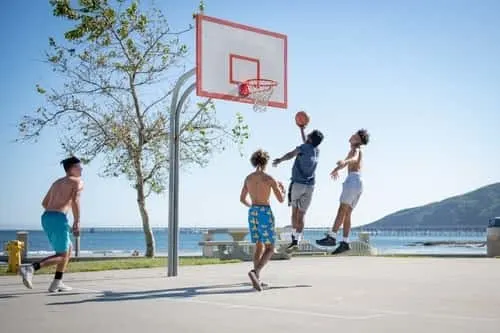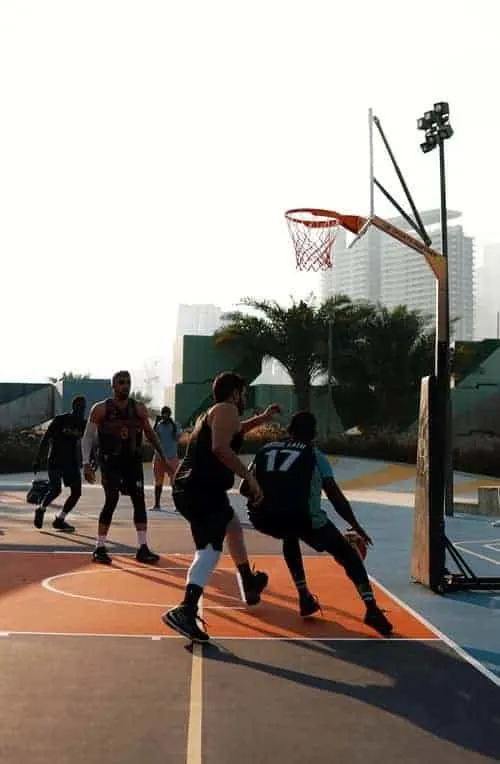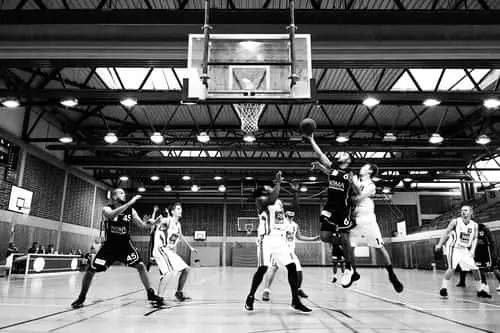I find it funny, I just watched Klay Thompson in NBA Finals take 3 steps on a fast break and throw down a dunk. Everyone immediately got angry and booed the refs as the Golden State Warriors were playing on the road in Game 2 against the Toronto Raptors. That’s Such an easy call for the ref, at least I think so. A call I never see go without a whistle blown Is the jump and then dribble.
Can you jump than dribble in basketball? No, You can not jump, then dribble. Once you lift your pivot foot off the ground, you must either shoot or pass the ball. Usually, this happens because you are going up to shoot the ball and realize that you are about to get your shot blocked so you decide to dribble.
I always wonder why so much confusion with the rules of basketball but I understand. From jump stops, to spin moves and air balls, we wonder well if that’s legal why not this. But what do the rules really say about traveling?
If you are interested in checking out the best basketball equipment and accessories then you can find them by Clicking Here! The link will take you to Amazon.com
Jump Then Dribble In Basketball? The Travelling Rule Explained
I kind of wish this illegal basketball move was legal, as a coach, it would force my players not to jump and block the ball every time a player shoots, as they try to pad their blocking stats. It would force them to close out on the player with the ball and have a hand up instead. If this was a legal move the best strategy would be to never jump, because then you could never get beat by the jump dribble. You should stay on the ground instead of falling for the pump fakes anyways.
Traveling in the NBA is one rule in the rule book that should be called a lot more than it does. Next time you are watching a game on TV or watching YouTube Clips, Watch the player with the ball lift up his pivot foot before he puts the ball down. That is a travel that rarely gets called especially if you are a star player in the NBA and it happens all the time. It is sometimes too quick for us to see but a referee with years of experience can see it easily.
We are going to look at the rule book courtesy of NBA.com and look at the official wording of what a travel is. Starting with the definition….
Section VIII—Traveling
Traveling is progressing in any direction while in possession of the ball, which is in excess of prescribed limits as noted in Rule 4—Section VII and Rule 10—Section XIII.
Rule 4 Section VII is the definition of the pivot foot. Rule 10 – Section XIII is the rules on traveling.
Rule 4 Section VII – Pivot a. A pivot takes place when a player, who is holding the ball, steps once or more than once in any direction with the same foot, with the other foot (pivot foot) in contact with the floor.
If your left foot is your pivot foot, you are allowed to take as many steps as you want with your right foot as long as you are left foot doesn’t lift up off the floor or slides in any direction.
b. If the player wishes to dribble after a pivot, the ball must be out of his hand before the pivot foot is raised off the floor. If the player raises his pivot off the floor, he must pass or
attempt a field goal before the foot is returned to the floor.
The definition of Section VII of the pivot foot fully explains the reason you can not jump and then dribble in basketball. People get this confused.
It is the pivot foot that must not leave the ground unless you go up for a shot or make a pass mid-air. If you decide to dribble, the pivot foot can also not leave the ground, until the ball touches the ground first.
I thought for the longest time it was the non-pivot foot that came second followed by the dribble. I know it sounds crazy that I could play basketball for many years and get this rule wrong all this time. I think sometimes your set in a way a rule is you don’t feel the need to examine it unless there is a rule change.
Now as far as a jump fake than a dribble, I imagine you could probably get away with a pump fake and go off one foot and raise on to your toes on that one foot, but I haven’t seen anyone manipulate it into an effective move.

Section VIII—Traveling (b) A player who receives the ball while he is progressing or uponcompletion of a dribble, may take two steps in coming to a stop, passing or shooting the ball. A player who receives the ball while he is progressing must release the ball to start his dribble before his second step.
That second step is the pivot foot in which it can not be lifted, once it is lifted that is the start of the second step.
4. A player who lands with one foot first may only pivot using that foot.
WOW! This surprised me the most because I have seen this happen many times in which players will land 1, 2 after grabbing a rebound and using the second foot that landed as their pivot foot in the attempt to make a pass around the defense.
I am not saying I want every travel called cause I believe it’s not realistic and it would completely slow down the game. I just want the three-step travels to stop a lot more than it is allowed currently.
5. A progressing player who jumps off one foot on the first step may land with both feet simultaneously for the second step. In this situation, the player may not pivot with either foot and if one or both feet leave the floor the ball must be released before either returns to the floor.
So again not only does the definition for pivoting explain why we can’t jump then dribble but also the rule of travel explains it up above.
Getting Away With Jumping than Dribbling In Basketball?
There is a way to get away with jumping and dribbling but I do not recommend it and it is not telling the ref midway in the air “What’s that over there”.
Here’s How…
You are going up for a shot and you realize the defense is lazy, and they decide that they won’t be able to close out on you. They then turn their back to look at the rim to rebound the ball. If they are close enough you could technically throw the ball off their back, grab it then continue to dribble or go up for a layup if you are close enough. It’s an advanced move but I would only do it for fun against your friends, not in a real basketball game.
It is also legal to shoot the basketball off the backboard if you get into trouble, then grab it and continue up for a shot. You are not allowed to dribble it again. Also, a tough move that I don’t recommend.
Rebound Than Dribble In The Air
I remember watching the all-star game years back when Allen Iverson was in his prime. He grabbed a rebound and on the way down he put it through his legs and continued to dribble it up the court. I remember that I thought it was the coolest trick at the time, well you can guess who practiced that move for the next few weeks. I was even able to pull it off a few times in pick up games as it wasn’t that difficult.

More on Rules
I always tell the players I coach, it just has to look like a foul or a violation, you don’t have to touch the player. I have seen and played with big men who drop step dunk but dribble with both hands to do it (aka the power dribble). That’s a tough call to make for a double dribble but really it doesn’t look like it so why make the call. The ref is focusing his attention on the contact as most important.
The NBA has gone as far as to have a former retired NBA referee join live games and talk to the commentators to explain calls for the officials on the court. Because almost everyone puts blame as to why their favorite team lost on to the refs. But not realizing one of many components to winning can easily be the reason for losing, such as making free throws. I guess that’s the ref’s fault too.
That concludes the article hoped you enjoyed and learned something new, feel free to check out my other content and stop by often as new content is constantly added.
Further Readings:
- What Is A Reach-in Foul? Explained
- Can You Save The Basketball To Yourself?
- Can Basketball Make You Taller? What Science Says
WB
Saturday 19th of August 2023
But what if you’ve never established a pivot foot? If you’re stationary, someone passes you the ball, and then you jump off 2 feet and start your dribble in the air, that would be legal, right?
Richard
Wednesday 10th of May 2023
There is a mistake in this article: "If you decide to dribble, the pivot foot can also not leave the ground, until the ball touches the ground first."
This is not true. The rule states "the pivot foot shall not be lifted prior to "releasing the ball" for a dribble" The ball doesn't have to touch the ground. It just has to be out of the players hands for a dribble attempt.
tom
Thursday 6th of October 2022
4. doesn't apply to getting a rebound or catching a pass in the air, only ending a dribble. Because you can't travel (or establish pivot) until you first establish possession, and you don't have possession just from catching a rebound or pass and putting your first foot down. This is talking about ending a dribble. You absolutely establish first foot down as pivot.